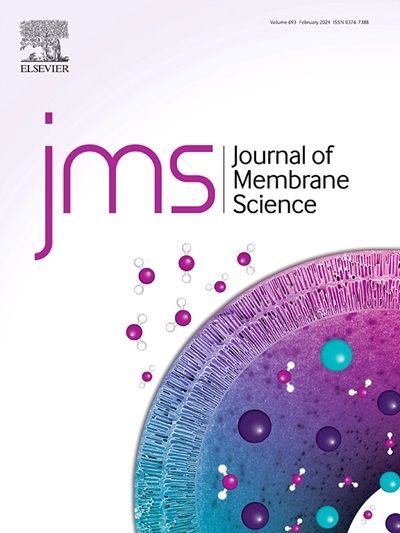Guanidinium covalent organic framework modulated positively charged polyamide membranes toward superior Li+/Mg2+ selectivity
IF 8.4
1区 工程技术
Q1 ENGINEERING, CHEMICAL
引用次数: 0
Abstract
Nanofiltration (NF) membrane separation technology offers significant potential for the effective Li+ extraction from salt-lake brines. Attaining high Li+/Mg2+ selectivity relies on increasing the positively charged density of the NF membrane surface. In this study, a guanidinium covalent organic framework (TbTG) nanosheet is designed to modulate positively charged polyamide (PA) thin-film nanocomposite (TFN) membranes. The TbTG nanosheets are synthesized and deposited on polyethersulfone ( PES) support alongside polyethyleneimine (PEI) to polymerize with trimesoyl chloride (TMC) and generate cross-linked PA-COF networks. The charge density of the membrane surface is increased to +1.48 mC m-2, nearly twice that of the pristine PA membrane. The enhanced positive chargeability stems from the guanidine and amino groups of the TbTG framework, creating a stronger Donnan exclusion to repel Mg2+. Meanwhile, the hydrogen bond interaction between TbTG and PEI monomers brings about decreased pore size of the membranes. Therefore, the optimal PA-COF-3 membrane demonstrates an ultrahigh MgCl2 rejection of 99.4%, as well as a superior separation factor () of 76.5 at a LiCl/MgCl2 mass ratio of 1:40, which exceeds the performance of most reported NF membranes.

求助全文
约1分钟内获得全文
求助全文
来源期刊

Journal of Membrane Science
工程技术-高分子科学
CiteScore
17.10
自引率
17.90%
发文量
1031
审稿时长
2.5 months
期刊介绍:
The Journal of Membrane Science is a publication that focuses on membrane systems and is aimed at academic and industrial chemists, chemical engineers, materials scientists, and membranologists. It publishes original research and reviews on various aspects of membrane transport, membrane formation/structure, fouling, module/process design, and processes/applications. The journal primarily focuses on the structure, function, and performance of non-biological membranes but also includes papers that relate to biological membranes. The Journal of Membrane Science publishes Full Text Papers, State-of-the-Art Reviews, Letters to the Editor, and Perspectives.
 求助内容:
求助内容: 应助结果提醒方式:
应助结果提醒方式:


